Insights
‘Climate risk is investment risk’: part 4.
Nature-based solutions: cleaning the air we breathe.
This is an ongoing insight series that looks at the opportunities of nature-based solutions. See part 1 & 2 here.
In part 3 we looked at how nature-based solutions can be employed as part of the toolkit when looking to address the issues of poor air quality and providing for a better, healthier environment. Specifically, we looked at the complexities around incorporating vegetation within a scheme to help enhance air quality.
We focused on how the mechanism of pollutant deposition supported this, but dispersion and absorption also need to be explored.
Pollutant dispersion.
The impact of the topography and structures present in our urban environments has a profound influence on pollutant dispersion.
In more open environments where buildings are more spread out and air can move more freely, polluted air flows over or through a vegetation barrier and over the green walls. In the same way as pollutant deposition, the pollutant concentrations then drop on the side of the structure furthest away from the pollution sources, reducing exposure to air pollution.
Open road environment.
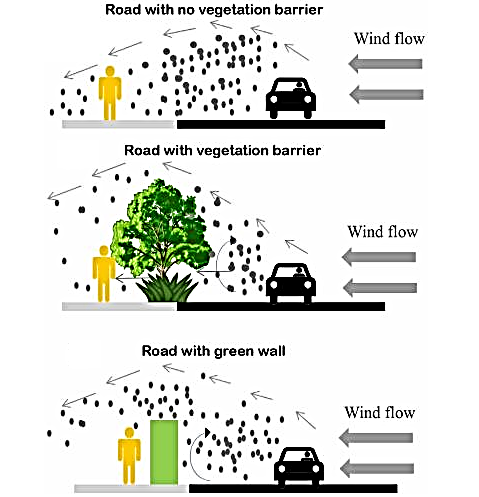
In contrast, trees are typically less effective in reducing air pollution in enclosed environments than open environments and can in fact have a detrimental effect on air quality within enclosed environments, limiting air movement and even aiding the build-up and accumulation of pollutants during certain conditions. This is particularly the case for trees that are planted closely together, highlighting the importance of managing the layout of any planting in enclosed environments so that they minimise the build-up of pollutants and where possible are harnessed to help support dispersion.
The presence of trees reduces the velocity of the wind, which can in certain circumstances limit the dispersion of pollutants and leads to their accumulation.
These principles can be applied to human made structures, such as green walls which may be used in a similar manner to hedges in forming barriers across an area. The design of these and their layout can be used to optimise air movements and aid the dispersion of pollutants – helping to manage any build-up of pollutants and also offering integration alongside other human comfort considerations such as temperature.
This use of structures and the layout of our environments could be used to treat poor air quality by channelling poor air quality through zones of planting to act as a natural air treatment system.
Enclosed environment.
No vegetation.
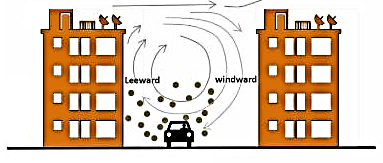
With trees.
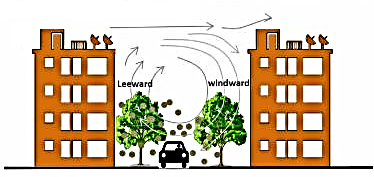
With hedges.
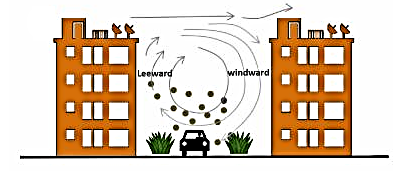
With green walls and roofs.
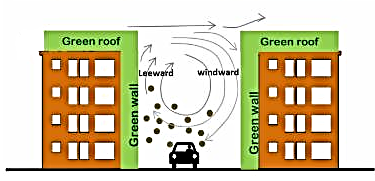
The influence of structures on dispersion in an enclosed environment. Source: Abhijith et al. (2017).
Pollutant absorption.
Vegetation can also remove pollutants through absorption, although generally to a lesser extent than deposition and dispersion.
Research on how absorption varies between different vegetation structures in different urban environments is limited. However, it has been noted that absorption can help to offset some of the adverse impacts arising from trees in enclosed environments under which pollutants are trapped at a low level. Also, as with deposition, the lower level of pollutant dispersal in enclosed environments increases the amount of contact time that the pollutants have with these systems, which can increase absorption.
Effectiveness.
There is a lot of ongoing research currently being undertaken in the UK to assess the effectiveness of various structures in reducing air pollution. Findings from some of the studies indicate that in enclosed environments, green walls can reduce NO2 and PM10 concentrations by up to 40% and 60% respectively, compared to up to 3% for green roofs, whilst in open environments, trees and hedges can reduce PM concentrations by up to 15.5%.
However, it should be noted that it is difficult to directly compare the results of studies that have been undertaken, as there are different factors affecting pollutant dispersion, deposition and absorption.
So what does it all mean?
It is clear that nature-based solutions do have a role to play in improving the quality of the air we breathe and that they should be incorporated within the design of our urban areas to reduce exposure to air pollution. An integrated approach is key in enabling this and, by engaging with the topic of air pollution at an early stage, the benefits of these solutions can be brought to bear.
The implementation of these nature-based solutions needs to be considered in a holistic way that incorporate potential air quality benefits, along with other factors such as their role in promoting biodiversity, improving well-being and reducing energy consumption.
Further research and improved understanding of how these solutions interact with the urban environment is ongoing, as shown by the various projects being undertaken by universities across the UK.
The University of Surrey’s Hedge Design for the Abatement of Traffic Emissions tool (HedgeDATETM) and the University of Birmingham’s Green Infrastructure for Roadside Air Quality (G14RAQ) software have been developed to rapidly quantify the effectiveness of vegetation structures in reducing air pollution in an accessible and user-friendly way.
The use of these two applications in research to date is limited due to only having been developed recently. However Pearce et al. (2021) utilised the G14RAQ software in their study to assess the effectiveness of a vegetation barrier in reducing roadside NO2 concentrations in California, USA, with the aim of reproducing results recorded previously by Deshmukh et al. (2019), who had used computational fluid dynamic modelling. The G14RAQ software performed well, with Pearce et al. (2021) recording a similar reduction in NO2 concentrations to Deshmukh et al. (2019) of 11.9%. This highlights the potential of these recently developed applications, along with others that are being developed elsewhere, in streamlining the development’s design process and in leading to a closer move towards integration within the design process.
Further to this, through their IGNITION Living Lab project, the University of Salford is aiming to create a model for urban green technologies to improve climate change resilience and help tackle problems such as poor air quality in Greater Manchester. The solutions from the model can subsequently be drawn upon when implementing green infrastructure in other cities beyond Greater Manchester.
Without doubt, a collaborative approach throughout the design process must be adopted, to ensure that not only nature-based solutions are firstly incorporated – but they are done so effectively to deliver a true benefit to the users of that site and beyond.
